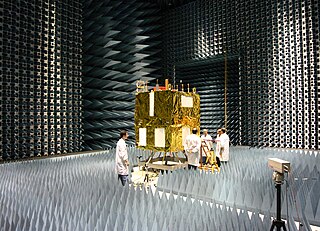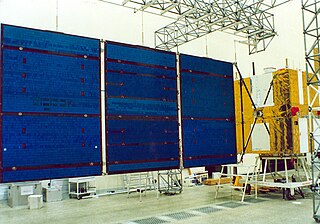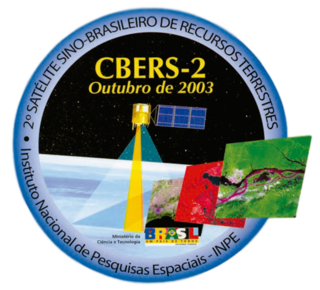
The Brazilian Space Agency is the civilian authority in Brazil responsible for the country's space program. It operates a spaceport at Alcântara, and a rocket launch site at Barreira do Inferno. It is the largest and most prominent space agency in Latin America.

Marcos Cesar Pontes is a Brazilian Air Force pilot, engineer, AEB astronaut, politician and author. He became the first South American and the first Lusophone to go into space when he docked onto the International Space Station aboard Soyuz TMA-8 on 30 March 2006. He is the only Brazilian to have completed the NASA astronaut training program, although he switched to training in Russia after NASA's Space Shuttle program encountered problems. After Jair Bolsonaro's election as President of Brazil in 2018, Pontes was officially nominated to be Minister of Science, Technology and Innovation, a post which he accepted days later and assumed when Bolsonaro's government began. He left the post on 31 March 2022 and in the same year was elected federal senator for his state, São Paulo.
Satélite de Coleta de Dados is a series of satellites developed in Brazil.
The Brazilian space program is the rocketry and space exploration programs conducted by Brazil from 1961, under GOCNAE until the creation of the Brazilian Space Agency in 1994. It has significant capabilities in launch vehicles, launch sites, and satellite manufacturing. It is based at the National Institute for Space Research (INPE), under the Ministry of Science and Technology (MCT). Upon its founding the program was under complete military control, which hindered its development, as other countries blocked technological development due to concerns over missile proliferation. In 1994, the space program was transferred to civilian control under the Brazilian Space Agency.

The China–Brazil Earth Resources Satellite program (CBERS) is a technological cooperation program between Brazil and China which develops and operates Earth observation satellites.

China–Brazil Earth Resources Satellite 2B (CBERS-2B), also known as Ziyuan 1-2B, was a remote sensing satellite operated as part of the China–Brazil Earth Resources Satellite program between the Chinese Center for Resources Satellite Data and Application and Brazilian National Institute for Space Research. The third CBERS satellite to fly, it was launched by China in 2007 to replace CBERS-2.

China–Brazil Earth Resources Satellite 1 (CBERS-1), also known as Ziyuan I-01 or Ziyuan 1A, is a remote sensing satellite which was operated as part of the China–Brazil Earth Resources Satellite program between the China National Space Administration and Brazil's National Institute for Space Research. The first CBERS satellite to fly, it was launched by China in 1999.

The Ministry of Science, Technology and Innovation of Brazil is the civilian cabinet organization which coordinates science, technology, and innovation activities in the country. It is headed by the Minister of Science, Technology and Innovation.

China–Brazil Earth Resources Satellite 2 (CBERS-2), also known as Ziyuan I-02 or Ziyuan 1B, was a remote sensing satellite operated as part of the China–Brazil Earth Resources Satellite program between the Chinese Center for Resources Satellite Data and Application and Brazilian National Institute for Space Research. The second CBERS satellite to fly, it was launched by China in 2003 to replace CBERS-1.

The Amazônia-1 or SSR-1, is the first Earth observation satellite developed by Brazil, helped by Argentina's INVAP, who provided the main computer, attitude controls and sensors, and the training of Brazilian engineers, and launched at 04:54:00 UTC on 28 February 2021.
The Flora Hiperspectral satellite, initially scheduled to launch in 2017, is a proposed Brazilian–American Earth observation satellite. It will produce hyperspectral surface images of comparable resolution to Landsat satellites. The Flora Hiperspectral is a joint project between the Jet Propulsion Laboratory (JPL) of NASA and the National Institute for Space Research of Brazil.

China–Brazil Earth Resources Satellite 3 (CBERS-3), also known as Ziyuan I-03 or Ziyuan 1D, was a remote sensing satellite intended for operation as part of the China–Brazil Earth Resources Satellite program between the Chinese Center for Resources Satellite Data and Application and Brazilian National Institute for Space Research. The fourth CBERS satellite to fly, it was lost in a launch failure in December 2013.

China–Brazil Earth Resources Satellite 4 (CBERS-4), also known as Ziyuan I-04 or Ziyuan 1E, is a remote sensing satellite intended for operation as part of the China–Brazil Earth Resources Satellite program between the Chinese Center for Resources Satellite Data and Application and Brazilian National Institute for Space Research. The fifth CBERS satellite to fly, it was successfully launched on 7 December 2014. It replaces CBERS-3 which was lost in a launch failure in December 2013.

Ricardo Magnus Osório Galvão is a prominent Brazilian physicist and engineer, formerly the Director-General of the National Institute for Space Research. He is a full Professor of the Institute of Physics of the University of São Paulo, member of the Brazilian Academy of Sciences, fellow of the Institute of Physics and councilman of the European Physical Society. Galvão has occupied major positions within the Brazilian Physics community such as the presidency of the Brazilian Physical Society (2013–2016) and the directorship of the Brazilian Center for Research in Physics (2004–2011).

The 2019 Amazon rainforest wildfires season saw a year-to-year surge in fires occurring in the Amazon rainforest and Amazon biome within Brazil, Bolivia, Paraguay, and Peru during that year's Amazonian tropical dry season. Fires normally occur around the dry season as slash-and-burn methods are used to clear the forest to make way for agriculture, livestock, logging, and mining, leading to deforestation of the Amazon rainforest. Such activity is generally illegal within these nations, but enforcement of environmental protection can be lax. The increased rates of fire counts in 2019 led to international concern about the fate of the Amazon rainforest, which is the world's largest terrestrial carbon dioxide sink and plays a significant role in mitigating global warming.

Diptychophora galvani is a species of moth in the family Crambidae. It measures about one centimeter in wingspan and is easily distinguished from all closely related species by the color pattern of its forewings. These are orange at their base and tip with a large intermediate gray patch, a pattern not found in any other species of Diptychophora. The female has grayish hindwings, while they are entirely white in the male. The genitalia of both male and female are also quite different from other members of this genus. The biology of the species remains completely unknown, including the host plant of the larval stage, although some species of the tribe Diptychophorini are known to feed on mosses.

The Institute of Aeronautics and Space is a military research organization of the Brazilian Air Force's Department of Aerospace Science and Technology (DCTA), founded on 1 January 1954.

VLS-1 V01 was the first launch of the VLS-1 rocket that took place on November 2, 1997, from the Alcântara Launch Center with the goal of putting the SCD-2A satellite into orbit. The launch was unsuccessful, with the rocket being remotely destroyed due to deviation from its trajectory.
VLS-1 V02 was the second flight of the VLS-1 rocket on December 11, 1999 from the Alcântara Launch Center, with the objective of placing the SACI-2 microsatellite in LEO. The rocket was remotely destroyed 3 minutes after launch.















